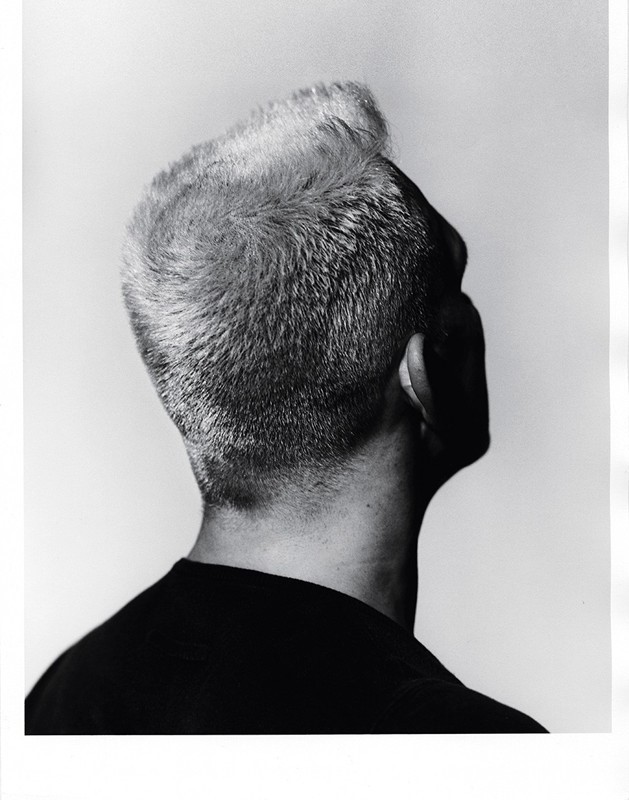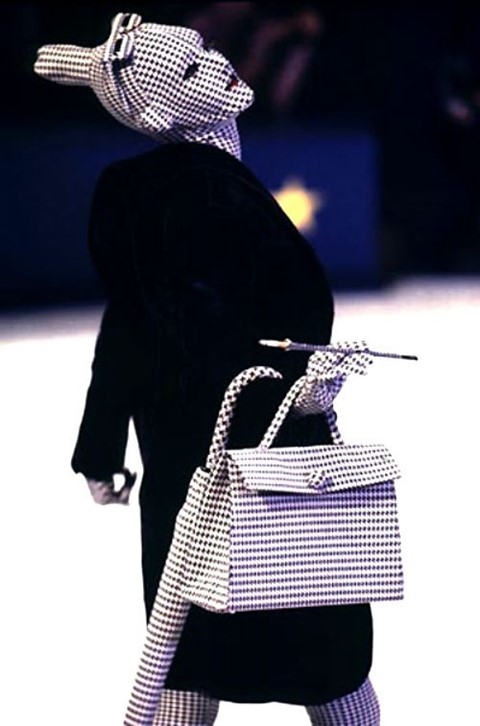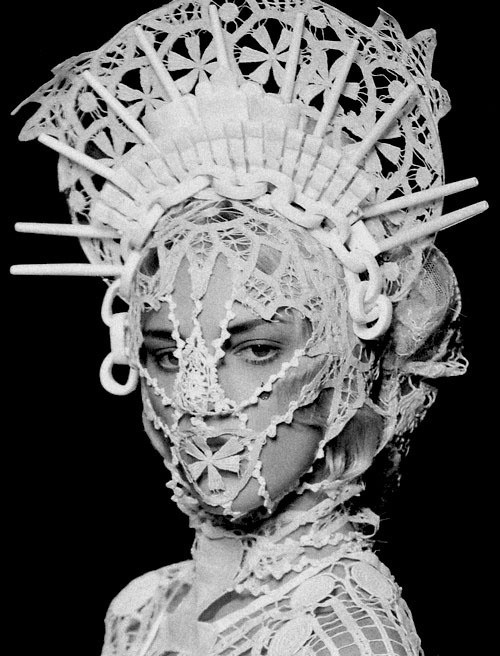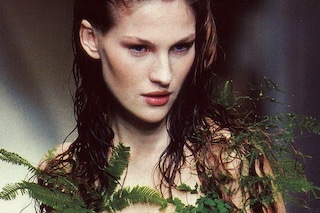As a new Gaultier retrospective opens, we revisit our feature with fashion's enfant terrible
Taken from the April 2013 issue of Dazed & Confused:
For more than 30 years Jean Paul Gaultier has been one of the world’s most influential and inventive designers. From codpieces and skirts for men and underwear as outerwear to androgynous women on the catwalk teasing and transcending the boundaries of gender and stereotyped images of femininity and beauty, Gaultier has firmly established himself as a fashion force for social transgression. Who else could introduce fetish, bondage, rubber and PVC to haute couture and get away with it? His designs brought high fashion to the high street and took street style to the catwalk, in a seductive fusion of the traditional and the radical. He is associated in the public’s mind with two of the most famous items in fashion iconography: the Breton sailor top, and a pointy cone bra that could take your eye out. Both are celebrated in his touring archive exhibition The Fashion World of Jean Paul Gaultier, which has just hit Rotterdam. That famous peroxide quiff is now slightly greying, but an hour in the presence of Gaultier is still an hour in the presence of fashion royalty, and that cheeky Parisian lilt is like listening to him on Eurotrash all over again. Ooh la la!
Dazed Digital: You said that on your 60th birthday last year you would stay in bed and cry rather than celebrate. Did you?
Jean Paul Gaultier: I don’t like birthdays so much; for me it’s not so important, it’s just symbolic. It’s not that you see a change has happened in yourself on that day, it’s more that you see the evolution of yourself over the years. It’s not at the moment I turn 60 that I suddenly change. I have this relationship with age because of my grandmother – I was so lucky because she gave me the image of getting older as something that was very sweet and very nice and about sharing stories, so from that point onwards I thought getting old was not that bad. But then when I see my arthritis starting to begin, like when I’m dancing, I think, ‘Uh oh!’ I would have loved to do Dancing With the Stars but I couldn’t, ha!
DD: Do you think you're ageing gracefully? Any kind of weird or wacky routines we should know about?
Jean Paul Gaultier: The thing is, I used to be able to eat whatever I wanted and I never got fat at all. At the age of 30, bang, I had to be more controlled. No more big packets of spaghetti for myself alone, ha! And then after 40 and 50 there is a little step up on getting fatter. So I started to diet again, which is not so bad because I feel my stomach is an obstacle and I cannot move as much as I would like!
DD: What do you do to get away from the fashion circus?
Jean Paul Gaultier: I like to go to the cinema and I also like watching TV. I am of a generation born with TV. My grandmother used to let me watch it on Wednesdays, Thursdays and Saturdays, and I loved seeing everything. I remember sometimes on a Sunday it was our tradition to go out in a little car and drive through the suburbs of Paris seeing the gardens and trees and everything, but I didn’t care, I just wanted to go back and see the films on TV! But with so many channels I tend to zap through everything now. I like watching old black-and-white movies, French or American, with stars like Bette Davis. Cinema is different though. I like to have the atmosphere, the big screen in front of you and all the traditional things like popcorn. I must say, in Paris we’re very lucky, there are a minimum of eight to ten new movies released every week, but I can’t see them all, especially around show times, so I normally try to go twice a week.

DD: You’ve always snubbed conventional dress codes and opted for provocation in your designs – how did that creative process evolve and how has it changed as time has gone on?
Jean Paul Gaultier: I’m always working but it’s not work, it’s my passion. It’s always a game I’m playing by seeing everything around me. So like, I’m with you now and I can see your studded bracelet, I see your hair, your boots, I see the books behind you on the shelf – you know, everything is part of a learning process. And when I go to London that always influences me too. I see the rebellion there, the way the extravagance of English eccentricity mixes with a rock’n’roll edge. I love that. It’s also about educating yourself – the things you don’t accept, the things you love, the things you ask, ‘Why are they like that?’ Like when you find out Santa Claus doesn’t exist, and if that’s true, then maybe God also doesn’t exist either, you know? I have always questioned things and explored my own truths: what is good, what is bad, what is elegant. Even when I worked at Jean Patou, the people that were selling the couture were saying, ‘Beige and gold is so chic,’ but me, I was thinking, ‘Eugh, disgusting, I prefer black already!’ And I also used to arrive at work wearing riding boots like a cavalier, and people would ask ‘where is your horse?’ in a bitchy way. But I love difference and to make my own conclusions.
Women can have a brain and also be beautiful, you know? And boys, with all the attributes of masculinity like money and manpower, I found it so stupid. So I chose to create unisex fashion
DD: You obviously believe in ‘vive la difference’, which can be seen in the diversity of models you use on the catwalk. Why is this so important to you?
Jean Paul Gaultier: When I cast models I love to show a variety of women. Beautiful sexy women with curves, ethnic women, androgynous women. I don’t want to have just one specific image of a woman in my shows, I want to present what really exists. And the same for men. I also like to show attitude.
DD: O ver the years you’ve earned yourself a reputation as an ambassador for androgyny. Where did your passion for challenging the masculinity/femininity boundaries stem from?
Jean Paul Gaultier: I think it came from many things. I didn’t play football at school and I was more of a sissy! I was also surrounded by women, especially my grandmother, and I found the company of girls more interesting than that of boys. You know, there is an expression in France that I find awful which is sois belle et tais-toi (‘be beautiful and shut up’), and so I was almost a feminist in that I realised there was an injustice there. Women can have a brain and also be beautiful, you know? And boys, with all the attributes of masculinity like money and manpower, I found it so stupid. So I chose to create a lot of unisex fashion, and that came from being fascinated by people I admired and who were heroines to me, like Edwige Belmore, the ‘queen of Paris punk’, who had bleached hair and tattoos and was like a couture punk. I put her into my James Bond-inspired AW79 show singing ‘My Way’ in the style of Sid Vicious. She also inspired me for the outerwear bra and man-jacket idea. It was like a kind of post-liberation of women – first they were burning their bras, and then they were putting them back on again, but this time in a rebellious and unique way, almost like an instrument of seduction.
DD: Talking of bras, before your conical design for Madonna came about, you created one for your very first teddy bear, Nana. Why? Did you ever think it would become such an important piece of fashion and music iconography?
Jean Paul Gaultier: You know, I wanted to have a doll to dress up but my parents didn’t want me to – ‘A doll, non, that’s for a girl, come on!’ – so I made my first transvestite teddy bear instead, ha! I never imagined the design would become what it has though. Nothing I have ever designed has been made as a deliberate fashion statement – I saw fashion advertising for bras in the 50s, and they were on pin-up girls and were a little pointy and sexy, so the conical bra was about my own self-education and interpretation of what women were wearing and liked.

DD: With women shaping much of your life and career, you’ve had many female muses, most notably Madonna. how did that relationship come about, and how has it evolved over the years?
Jean Paul Gaultier: The first time I saw Madonna was in the ‘Holiday’ video, and I remember thinking she must be British, because Americans couldn’t dress like that. She was and still is very European in reality and her look then was a mix of what I was doing – it was very underground. I loved how she was creating her own look and didn’t need a stylist. I remember seeing her later on in another video clip where she was wearing a black and gold corset, and it was like one of my own designs but it was by Frederick’s of Hollywood, and I thought, ‘Why didn’t she ask me to do that?’ So later on at a party I gave her some sketches of designs I had in mind for her and then one year later, between one of my shows, someone said, ‘Madonna called and she wants you to call her back,’ and I said, ‘Yes, okay, okay,’ thinking they were making fun of me, and then after the show I said, ‘But it was true that story of Madonna, non?’ So we eventually spoke and she knew what she wanted from me and I knew how to create that, and I was also a big fan too, so it was perfect. It still is. It has been one of the most incredible collaborations of my career.
DD: What would a typical night out together involve?
Jean Paul Gaultier: Well, she has a family now of course, but when we used to go out everything was always arranged, usually by her, ha! And we would go for dinner and she never spoke about business, never, never, never – but gossip yes! Bitchy things, yes! And sexy things, yes! The first time I went to New York it was after Thanksgiving, and we went out to some parties and then to a club where she was casting for a show. It was super organised with a mix of work too. I love that about her, that she’s always researching and being influenced wherever she goes.
You know, I wanted to have a doll to dress up but my parents didn’t want me to – ‘A doll, non, that’s for a girl, come on!’ – so I made my first transvestite teddy bear instead
DD: Aside from Madonna, obviously, are you a music fan – how does it play out in your daily life?
Jean Paul Gaultier: I used to buy albums, but to listen and like one completely for me is very rare. I usually like only one or two tracks. I also like music videos. I like to hear and discover underground things, and to be conditioned by music, to find things by accident or surprise. There are people who are like technicians, they have more music knowledge than me and an ear for music, but when I’m planning shows, for example, I already have a 99 per cent idea of what I like, and the atmosphere is what’s important – I always want to provoke some emotion and reaction with the music that goes with or contrasts with my collections.

DD: Your SS13 show was a homage to your favourite musical icons. How important are they to you?
Jean Paul Gaultier: It’s about connecting the muse as a model to the muse as a singer and artist, like Bowie and Grace Jones. It’s that mix of music and imagery – the visual becomes something to connect with. All the big stars I admire have a strong image and it reflects that connection from me to them. It comes from within you if the music and image is strong and effective. I also loved that stars like Bowie were using their image to say that even with a more feminine and outrageous look, they could still please a girl visually.
DD: You have a strong connection with film, having created so many iconic costumes for the big screen. Did you have to change your approach for the cinema?
Jean Paul Gaultier: Movies are where I learnt that I wanted to be a fashion designer. In my exhibition there is an old TV showing a blackand-white film from 1945 called Falbalas (aka Paris Frills). It’s about a couturier who falls in love with his muse who is also his best friend’s fiancée, and he dies in the end because he’s carrying a mannequin that he thinks is her (he’s gone a little crazy in his mind), and he jumps to his death from a balcony. I cry each time I see it, but it gave me my vocation in life. It directed the way that I should make fashion – somebody in action, making the clothes, doing the fittings, having a muse. It was a very good portrait of the profession.
DD: What did you want to do before that?
Jean Paul Gaultier: I wanted to be a pastry chef! And then I wanted to make costumes for Les Folies Bergère, but after I saw Falbalas I knew I wanted to be a designer. Sometime later I met the actress from the film (Micheline Presle), who is 91 years old now, and I told her, ‘It’s because of you I wanted to have a muse and become a designer, I loved you!’ She told me that the director (Jacques Becker) was so supportive of couture because he was a personal friend of (couturier) Marcel Rochas, who created the clothes for the movie.

DD: The breton stripe or sailr top has become a signature staple in your collections. What drove your fascination with this nautical style?
Jean Paul Gaultier: I have a fixation with stripes! When I was a child I used to wear striped tops, and when I was an adolescent I used to wear them because flea markets were in fashion and the tops were cheap, and then I saw the Marine Francaise (French Navy) tops and I liked the graphic style. My fascination for using it in my collections began when I was designing a raincoat collection and I sketched a coat with stripes. Little by little I used more variations of it.
DD: Describe your overall design vocabulary. Will you continue to be provocative in the future?
Jean Paul Gaultier: My design reality is not about my own fantasy, it’s more about what I feel people want and feel. At the beginning I used to read the critics of the great couturiers, like Yves Saint Laurent, Cardin etc, and I tried to imagine why some of them were described as ‘controversial’ and ‘shocking’. But you know, Yves Saint Laurent was very aware of what people wanted and I have that same spirit – I love to listen, to feel and most of all, to be spontaneous.
The Fashion World of Jean Paul Gaultier: from the Sidewalk to the Catwalk is at the Brooklyn Museum until Feb 23rd 2014










